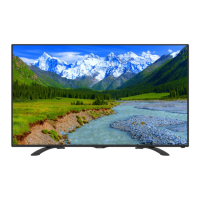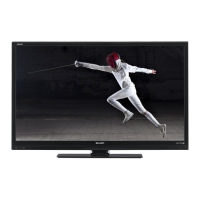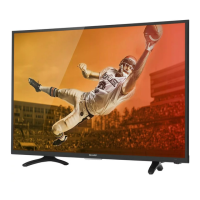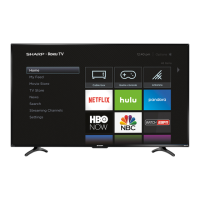How to reset parental control password on Sharp LC-50LB150U LED TV?
- GgilbertlauraSep 17, 2025
To regain access to parental controls on your Sharp LED TV if you've lost the password, enter 9999 to access parental controls, then set a new password.
How to reset parental control password on Sharp LC-50LB150U LED TV?
To regain access to parental controls on your Sharp LED TV if you've lost the password, enter 9999 to access parental controls, then set a new password.
What to do if Sharp LC-50LB150U LED TV says no signal?
If your Sharp LED TV displays a 'No signal' error message, first press the INPUT button to select the correct input for your device or service. If using a cable or satellite box, use its remote to change channels and ensure you've selected the correct input for viewing those channels.
Why does my Sharp LC-50LB150U LED TV have picture but no sound?
If your Sharp LED TV has good picture but no sound, try the following: increase the volume, make sure the sound isn't muted, and ensure headphones are disconnected. Also, verify the correct audio mode is selected and that all audio cables are correctly and securely connected to your TV. Finally, ensure the antenna or cable TV is securely connected.
Why does my Sharp LC-50LB150U have no picture or sound?
If your Sharp LED TV has no picture and no sound, start by pressing the power button on the TV or remote. Ensure the 'Audio Only' option is set to Off and that all video cables are securely connected. Adjust the contrast and brightness settings. Verify the power cord is plugged in, the correct video input source is selected, and try another channel. Also, ensure the incoming signal is compatible and that the antenna or cable TV is connected correctly. Finally, check the closed caption settings, as some TEXT modes can block the screen.
Why does my Sharp LC-50LB150U have a few bright or dark spots?
A few bright or dark spots on an LCD screen of Sharp LED TV is normal and does not affect the operation of your TV.
How to stop Audio Return Channel setting from turning back on Sharp LC-50LB150U LED TV?
To prevent the Audio Return Channel setting on the CEC menu of your Sharp LED TV from turning back on after it is turned off, turn off the CEC Control feature.
What to do if Sharp LC-50LB150U has good sound but poor color?
If your Sharp LED TV has a good sound but poor color, adjust the contrast, color, and brightness settings.
What to do if Sharp LC-50LB150U LED TV has no power?
If your Sharp LED TV has no power, ensure the power cord is correctly connected to both the TV and a power outlet. Unplug the power cord, wait 60 seconds, then plug it back in and turn on the TV. Also, other devices, such as a surround sound receiver, external speakers, fans, or hair dryers, might be interfering with your TV. Try turning off one device at a time to determine which device is causing the interference, then move it further from the TV.
Why does my Sharp LC-50LB150U LED TV not turn on when I turn on my device?
If your Sharp LED TV does not turn on when you turn on your device, ensure that the CEC Control feature is enabled. Also, make sure that TV Auto Power On is set to On in the CEC menu. Note that the device may not support this feature.
Why is my Sharp LC-50LB150U playing audio but not displaying video from a connected device?
If your Sharp LED TV is playing audio from a connected device but not displaying the video, ensure the MHL cable is securely connected to your TV and the device. Also, verify that you are using an MHL cable. Try adjusting the picture settings on your TV. Some apps may not work on your TV, depending on how the app developer programmed them.
Safety tips for TV placement and use to prevent injuries.
Guidelines for securely mounting the TV to a wall.
Connect MHL devices for screen mirroring and audio.
Manage HDMI CEC compatible devices for plug-and-play control.
Improves picture clarity and reduces motion blur for action scenes.
Automatically adjusts TV settings for an optimal gaming experience.
Step-by-step guide to attach the TV stand.
How to securely attach the TV to a wall mount bracket.
Lists all items included in the TV package.
Identifies side panel ports and connections for various devices.
Identifies back panel ports for power and device connections.
How to insert batteries into the remote control.
Proper direction for remote control operation.
Connects cable/satellite box via HDMI for best quality.
Connects cable/satellite box via DVI with audio.
Connects cable/satellite box via component video.
Connects cable/satellite box via composite video.
Connects cable/satellite box via coaxial cable.
Connects DVD/Blu-ray player via HDMI for best quality.
Connects DVD/Blu-ray player via DVI with audio.
Connects DVD/Blu-ray player via component video.
Connects DVD/Blu-ray player via composite video.
Connects game consoles via HDMI for optimal experience.
Connects game consoles via component video.
Connects game consoles via composite video.
Connects computer via VGA for display.
Connects computer via HDMI for display.
Connects computer via DVI with audio.
View JPEG images from a USB flash drive.
Browse photos marked as favorites.
Display photos automatically in a slideshow format.
Adjust slideshow repeat, shuffle, interval, and effect.
Connects home theater via digital optical audio.
Connects home theater via analog audio.
How to insert batteries into the remote control.
Proper direction for remote control operation.
How to power the TV on and put it in standby mode.
How to choose the active video input for the display.
Guide to using the on-screen menu navigation controls.
How to display program and signal details.
How to increase, decrease, or mute volume.
Configure picture mode that applies on TV startup.
Choose where TV audio is played (headphones, fixed/variable out).
Skip selected channels in the channel list.
Create a custom list of preferred channels for quick access.
Check digital signal strength to optimize reception.
How to set or change the parental control password.
Block TV programs that do not have a rating.
Set rating levels for content access based on US/Canada standards.
Download program rating data for parental controls.
Enable or disable text display for audio content.
Choose analog captioning display style and format.
Choose digital captioning display style and format.
Customize digital CC font, color, opacity, and edge effects.
Change the on-screen menu language to English, French, or Spanish.
Enable/disable automatic input source detection.
Enable or disable HDMI CEC device control features.
Automatically power off connected CEC devices when TV is turned off.
Automatically turn on TV from connected CEC devices.
Control audio receiver volume with TV remote via ARC.
View a list of connected HDMI CEC devices.
Turn on CEC-compatible devices from standby mode.
Access a CEC device's main menu using the TV remote.
Connect and view content from MHL-enabled mobile devices.
Connect and view content from a Roku Streaming Stick.
Reset all TV settings to factory defaults.
Display TV software version and other diagnostic details.
Solutions for problems with MHL or Roku streaming devices.
Solutions for problems related to CEC device compatibility.
Compliance with FCC Rules and Regulations for digital devices.











